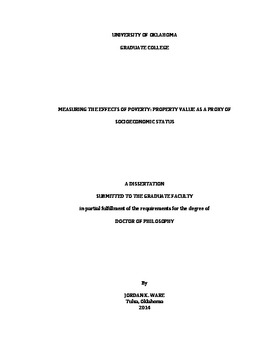| dc.contributor.advisor | Forsyth, Patrick B. | |
| dc.contributor.advisor | Adams, Curt M. | |
| dc.contributor.author | Ware, Jordan K. | |
| dc.date.accessioned | 2014-08-14T13:12:14Z | |
| dc.date.available | 2014-08-14T13:12:14Z | |
| dc.date.issued | 2014-08 | |
| dc.identifier.uri | https://hdl.handle.net/11244/10494 | |
| dc.description.abstract | This study explored property value as a proxy of socioeconomic status. The effects of poverty on general health, academic achievement, and child development are devastating. The endurance and growth of poverty can be disheartening. Improvement efforts must be targeted and evidence-based. Dependable evidence requires sound measurement. Traditional measures of socioeconomic status like eligibility for a free or reduced price lunch (FRL), parent income, parent education, and parent occupation leave room for improvement. Hierarchical linear modeling and regression analyses were conducted to compare the effects of FRL eligibility and property value on Math achievement. Geographic Information Systems was utilized to map the effects of property value on student achievement at the school level across a geographical area. The inclusion of visual evidence aids in identifying trends and, eventually, targeting improvement efforts. | en_US |
| dc.language | en_US | en_US |
| dc.subject | Education, Tests and Measurements. | en_US |
| dc.subject | Education, Social Sciences. | en_US |
| dc.title | Measuring the Effects of Poverty: Property Value as a Proxy of Socioeconomic Status | en_US |
| dc.contributor.committeeMember | Edwards, Beverly | |
| dc.contributor.committeeMember | Mackey, Hollie J. | |
| dc.contributor.committeeMember | Schaefer, Shawn | |
| dc.date.manuscript | 2014-08 | |
| dc.thesis.degree | Ph.D. | en_US |
| ou.group | Other | en_US |
